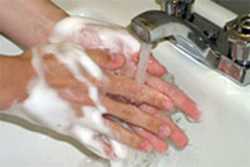Disease Detectives at Work—Detecting Salmonella Infections from Backyard Flocks
Easy to prevent, yet multiple large outbreaks continue to occur

A growing hobby of people around the country is to keep live poultry (chicks, chickens and ducks) in backyard flocks. This trend may be contributing to an ongoing increase in Salmonella outbreaks linked to these birds. In 2012, eight outbreaks of human Salmonella infections from contact with live poultry obtained from mail-order hatcheries occurred in the United States. These outbreaks resulted in 517 illnesses, 93 hospitalizations and 4 deaths.
Backyard flocks can be a great source of entertainment for families and allow for the production of fresh, local eggs. However, the risk associated with owning backyard flocks is one that most people are not aware of, according to Dr. Casey Barton Behravesh, Deputy Branch Chief for the Outbreak Response and Prevention Branch for CDC’s Division of Foodborne, Waterborne, and Environmental Diseases.
“Most people can tell you that raw poultry might be contaminated with Salmonella and that they should wash hands after handling the raw meat, but they don’t know that live poultry might also carry Salmonella germs that can make people sick,” according to Dr. Barton Behravesh, who is also a veterinarian.
CDC’s Outbreak Response and Prevention Branch has been working with state and local health and agriculture officials, the mail-order hatchery industry, the feed store industry, and the USDA’s National Poultry Improvement Plan (USDA-NPIP) to prevent illnesses from poultry in backyard flocks. Coordinated “One Health” efforts involving human, animal, and environmental health officials were critical to the detection and control of these outbreaks. These outbreaks could have become larger without persistent and collaborative prevention efforts.
Reaching Consumers through the Sellers
In order to prevent additional outbreaks, CDC scientists have provided advice through various ways to mail-order hatcheries, feed stores, and others that sell or display live poultry. One example is a health-related educational poster, which public health and agricultural officials recommend be posted and distributed to customers to inform them about the health risks and simple things that can be done to prevent illness.
Recent efforts by CDC and state departments of health and agriculture include working with feed stores across the country to improve the safety of live poultry displays, where historically children have been able to directly handle day-old chicks and ducklings. Now, many feed stores are introducing fencing and barriers so that children and other customers can look, but not touch, the birds unless they are purchasing them.

CDC and USDA-NPIP are also working directly with mail-order hatcheries, which often supply the birds to feed stores or directly to customers through the mail. Several productive conference calls with the industry have discussed past and ongoing outbreaks and how public health officials and the industry can work to together to prevent illnesses and outbreaks.
Mail-order hatcheries, agricultural feed stores, and others who sell or display chicks, ducklings and other live poultry should provide health-related education to owners and potential purchasers of these birds prior to the point of purchase. This should include information about the risk of acquiring Salmonella infection from contact with live poultry.
Following the Outbreaks
In April 2013, CDC released an announcement stating that the agency is collaborating with public health and agriculture officials in many states and the USDA’s Animal and Plant Health Inspection Service (USDA-APHIS) to investigate two large, multistate outbreaks of human Salmonella infections linked to contact with live poultry in backyard flocks. Updates continue to be posted as these outbreak investigations continue.
How Poultry in Backyard Flocks Can Make People Sick
Contact with live poultry, including baby or adult birds, can be a source of human Salmonella infections. These birds typically appear healthy and clean, but can be shedding germs that can make people sick. Always wash hands thoroughly with soap and water right after touching live poultry or anything in the area where they live and roam. Adults should supervise hand washing for young children. Additional recommendations are available.
Additional CDC Resources
- Page last reviewed: March 19, 2014
- Page last updated: March 19, 2014
- Content source:


 ShareCompartir
ShareCompartir